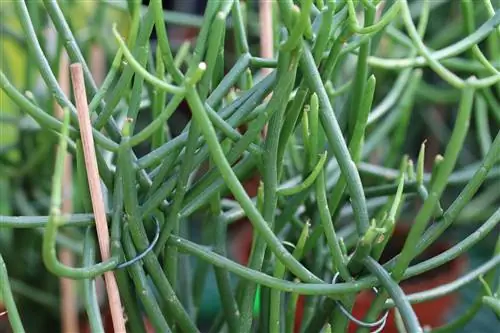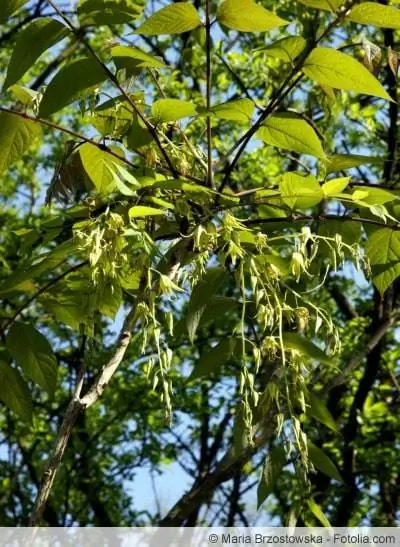- Author admin [email protected].
- Public 2023-12-17 03:39.
- Last modified 2025-01-24 12:45.
As a houseplant, the tropical pencil tree creates an extravagant ambience thanks to its supple, deep green branches. In creative living space design, the densely branched spurge plant serves as an attractive eye-catcher and at the same time a frugal roommate. The vernacular also aptly calls it a spaghetti bush or a milk tree. As long as enough attention is paid to the poison content of Euphorbia tirucalli, cultivation does not cause any difficulties, even for beginner gardeners. The following lines explain what exactly skilled care is about and how propagation is handled.
Profile
- Plant family Euphorbiaceae
- Name of the species: Pencil bush (Euphorbia tirucalli)
- native to the tropical climate of Africa
- Growth height in cultivation up to a maximum of 3 meters
- small, oval leaves for a short time
- flexible branches of rubbery structure
- inconspicuous flower
- poisonous in all parts
The pencil bush with green branches is predominantly known. There are also decorative varieties with yellow and red shoots circulating.
Location
Considering a tolerable minimum temperature of 12 °C, outdoor cultivation for the pencil bush is out of the question in these latitudes. In any case, its phenomenal silhouette comes into its own better in the elegant bucket. Whether you cultivate the African milk tree as an indoor plant all year round or display it in a prominent position on the balcony throughout the summer is up to your individual decision.
- full sunny, warm location at the south window of the house
- a light-flooded outdoor space from May to September
- Protection from pelting rain is recommended
Euphorbia tirucalli is not very comfortable in partially shaded locations. If there is a lack of brightness, the plant just worries about itself. If you are considering a corner of the living room as a location, additional artificial lighting is essential.
Substrate
The pencil bush is well positioned for professional care in a permeable substrate that is not necessarily bursting with nutrients. Although the high proportion of milky sap in the succulent branches suggests otherwise, the tropical plant cannot benefit from humus-rich soil with plenty of water-storing power. This is what the plant soil should be like:
- loose pot plant soil with 70 to 75 percent mineral content
- Suitable additions are lava granules, pumice gravel, perlite, vermiculite and fine-grained grit
An excellent substrate mixture makes commercial cactus soil with sand or another inorganic additive. In this case, the humus content is at the desired low level from the start.
Tip:
The pencil bush is considered a first-class candidate for hydroponics, which will particularly please hobby gardeners who are short on time.
Watering and fertilizing
As a prime example of an easy-care plant, the African spurge plant is frugal when it comes to water and nutrient supply.
- water gently when the soil surface is dry
- If the branches hang limply, there is a need for watering
- give the water directly to the roots and do not water overhead
- apply a liquid cactus fertilizer every 4 weeks from March to August
It is preferable to use collected rainwater to water the pencil bush. Alternatively, hang a cotton bag with peat moss in 10 liters of tap water overnight to reduce the lime content.
Cutting
One of the typical characteristics of spurge plants is their good tolerance to cutting. Given the remarkable growth of a milk tree, the size can be easily controlled. Sap flow can be reduced somewhat if you prune during winter dormancy. At the latest when the plant begins to go bald in the lower area, the shoots are shortened by at least a third of their length. Please only approach the work with protective gloves and glasses, because the toxicity of Euphorbia tirucalli should not be underestimated. Treat the 'bleeding' cuts with a cloth that is repeatedly dipped in hot water.
Wintering
From September onwards, a pencil bush prepares for winter dormancy. As the outside temperature drops, the plant moves indoors. How to manage wintering:
- It is as bright as possible at the location
- temperatures are around 15 °C
- the warmer the location, the sunnier it should be
- water only a little and do not fertilize
Spending the winter outdoors is almost certainly fatal for the tropical plant. On the other hand, if you give it a bright, cool winter quarters, it will gather fresh strength to sprout again from March/April.
Repotting
If the volume of the pot is no longer sufficient, there is a good opportunity to transplant after the winter break. Since the spaghetti tree grows rapidly not only above ground but also underground, the new planter can be up to 10 cm larger in diameter.
- spread out drainage made of pebbles in the new bucket over the bottom opening
- Place a water- and air-permeable fleece over it so that it doesn't get clogged
- followed by a layer of substrate of 5 cm
After unpotting, as much of the used soil as possible should be removed from the root ball. Then insert the pencil bush in the middle and fill the gaps with substrate. Don't forget to leave a 3-4 cm pouring edge.
Tip:
A freshly purchased pencil bush is immediately repotted into a larger pot to promote its vitality.
Propagate
As part of pruning or during the summer, a milk tree is propagated using cuttings. It is best to cut off several specimens, as the extreme succulence can cause rot.
- Cut suitable cuttings just below a leaf node.
- A length of 10-15 cm is recommended.
- First let the cuttings dry for 1-2 days.
- Fill cultivation pots with lean substrate or coconut fibers.
- Insert a cutting in each and water with rainwater.
By placing a plastic bag over each pot, you create a tropical microclimate that encourages rooting. Ideally, you should place the container in a bright, warm indoor greenhouse. While the substrate is kept constantly moist, an independent root system develops. If fresh shoots signal a successful outcome, the cover can be removed. As you continue, repot the young plant into substrate for adult Euphorbia tirucalli.
Diseases and pests
The Euphorbia tirucalli adds robust disease and pest resistance to its long list of beneficial attributes. If problems arise, they usually result from an inadequate water and nutrient balance. Watering too much is common, which causes waterlogging and rot. If the plant muffles from the root area, ascomycete fungi spread here, against which there is no control agent. As a last resort, repotting into fresh, dry substrate is an option.
Conclusion of the editors
As a prime example of an easy-care plant, the pencil bush is recommended as an extravagant houseplant. The African spurge plant likes to spend the summer on the balcony to attract everyone's attention. Cultivation has the best chance of success if the substrate is essentially mineral and therefore well-drained. Further care is then reduced to watering with rainwater and monthly fertilization. If you meet the need for vegetation to rest from September to March, the Euphorbia tirucalli will thank you for this care with years of vitality. Propagation is also easy by hand using cuttings in a lean substrate. The only drawback is the toxicity of the latex, which can be kept under control by taking adequate precautions.
What you should know about the pencil bush in brief
- The pencil bush comes from South Africa, loves warmth and should be kept warm and sunny.
- It tolerates the blazing sun and can easily be kept outdoors in summer.
- However, he should slowly get used to the UV radiation.
- At the beginning of the outdoor season, the plant should be placed in the shade and only receive sun in the morning and evening.
- A bright location is important even in winter. Temperatures can be high, but they should never fall below 12 ºC.
- Standard soil, which contains 70 percent mineral additives, can be used as a planting substrate.
- The soil should be permeable and not too rich in humus. Drainage in the pot is very useful.
- When planting, you must be very careful not to injure the delicate shoots, as any injury will cause the plant to bleed.
- The shoots break off very quickly, but you can let them root again.
- The pencil bush doesn't need a lot of water, on the contrary, too much of it is more damaging.
- So water is sparse, in winter just enough so that the shoots don't become limp.
- The pencil bush can survive without water for 4 weeks. Fertilization is carried out once a month in summer, preferably with cactus fertilizer.
- The plant is propagated by sinkers. Mature stems are separated at a leaf node.
- You can put it in a glass of water to root or let it dry a little
- Then let it root immediately in a sandy, only moderately moist substrate.
- As a container plant, the pencil bush grows quite quickly. If it gets too tall, it can be easily trimmed.
- Mealybugs and spider mites can infest the pencil bush. Agents based on potassium soap, paraffin oil or neem are suitable for combating this.
- Mildew can also occur, but this is rare.
- Be careful, the milky sap of the plant is poisonous!






